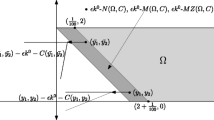Abstract
A vector optimization problem is given by a feasible setZ⊑ℝn, a vector-valued objective functionf: ℝn→ℝl, and an ordering coneCℝℝl. We perturb the ordering cone in such a way that the weakly efficient points of the “perturbed” vector optimization problem given byZ, f, and the perturbed cone are efficient points of the original problem. Especially this means that scalarization methods, which compute in general only weakly efficient points, determine efficient points of the original problem, when they were applied to the perturbed problem.
It turns out that the efficient points are the limits of weakly efficient points of the perturbed problems, letting the perturbation tend to zero. On the basis of this, a reference point algorithm is formulated. Finally, we apply this algorithm to a structural optimization problem.
Similar content being viewed by others
References
Arrow KJ, Barankin EW, Blackwell D (1953) Admissible Points of Convex Sets. In: Kuhn HW, Tucker AW (eds) Contribution to the Theory of Games, II. Princeton University Press, Princeton, NJ, pp 87–91
Benson B (1979) An Improved Definition of Proper Efficiency for Vector Maximization with Respect to Cones. J Math Anal Appl 71:232–241
Bernau H (1987) Interactive Methods for Vector Optimization. In: Brosowski B, Martensen E (eds) Optimization in Mathematical Physics. Lang Verlag, Frankfurt, pp 21–36
Bitran GR, Magnanti TL (1979) The Structure of Admissible Points with Respect to Cone Dominance. J Optim Theory Appl 29:573–614
Brosowski B (1985) Application of Parametric Programming to the Optimal Design of Stiffened Plates. In: Brosowski B, Deutsch F (eds) Parametric Optimization and Approximation. Birkhäuser, Basel Boston Stuttgart, pp 47–69
Brosowski B (1989) A Recursive Procedure for the Solution of Linear and Nonlinear Vector Optimization Problems. In: Eschenauer HA, Thierauf G (eds) Discretization Methods and Structural Optimization — Procedures and Applications. Springer, Berlin Heidelberg New York, pp 95–101
Brosowski B, Conci A (1983) On Vector Optimization and Parametric Programming. Segundas Jornados Latino Americans de Matematica Aplicada 2:483–495
Brosowski B, Conci A (1983) On the Optimal Design of Stiffened Plates. Anais VII. Congresso Brasileiro de Engenharia Mecanica, vol D, pp 169–178
Guddat J, Guerra Vasquez F (1987) Multiobjective Optimization Using Pivoting and Continuation Methods. Archiwum Automatyki I Telemechaniki 4:301–317
Hartley R (1978) On Cone-efficiency, Cone-convexity, and Cone-compactness. SIAM J Appl Math 34:211–222
Helbig J (1989) Stability and Stability Sets in Nonlinear Vector Optimization. Preprint
Helbig S (1990) An Algorithm for Quadratic Vector Optimization Problems. Z Angew Mathe Mech 70:T751-T753
Helbig S (1990) An Interactive Algorithm for Nonlinear Vector Optimization. Appl Math Optim 22:147–151
Helbig S (1990) On some Interactive Methods for Quadratic Vector Optimization Problems. Preprint, University of Frankfurt
Helbig S (1990) Scalarization in Vector Optimization by Cone Perturbation. Talk at the “Operations Research 1990”, Wien, Austria, 28.–31. 8. 1990
Henig MI (1982) Proper Efficiency with Respect to Cones. J Optim Theory Appl 36:387–407
Henig MI (1982) A Cone Separation Theorem. J Optim Theory Appl 36:451–455
Jahn J (1988) A Method of Reference Point Approximation in Vector Optimization. O R Proceedings 87:576–587
Jahn J (1989) An Interactive Method of Reference Point Approximation in Vector Optimization. Talk at the “14th Symposium on Operations Reserach”, Ulm, Germany, 6.–8. 9. 1989
Lawo M, Murray NW, Aust FIE, Thierauf G (1978) Optimization of Stiffened Plates. Civil Engineering Transactions, pp 13–16
Nožička F, Guddat J, Hollatz H, Bank B (1974) Theorie der linearen parametrischen Optimierung. Akademie-Verlag, Berlin
Pascoletti A, Serafini P (1984) Scalarizing Vector Optimization Problems. J Optim Theory Appl 42:499–524
Rockafellar RT (1970) Convex Analysis. Princeton Univ Press, Princeton
Weidner P (1990) An Approach to Different Scalarizations in Vector Optimization. Wissenschaftliche Zeitschr der TH Ilmenau 36:103–110
Weidner P (1990) On Proper Efficiency in the Sense of Geoffrion. Talk at the XV. International Conference “Mathematical Optimization — Theory and Applications”, Eisenach, Germany, 10.–14.12. 1990
Wieland U (1991) Anwendung eines Vektoroptimierungsproblems auf den optimalen Entwurf versteifter Platten. Diplom-Thesis University of Frankfurt
Wierzbicki AP (1986) On the Completeness and Constructiveness of Parameteric Characterizations to Vector Optimization Problems. OR Spektrum 8:73–87
Wolf K (1988) Sensitivitätsanalyse bezüglich der Änderung der Dominanzsstruktur bei linearen Vektormaximumproblemen. Dissertation, FU Hagen
Yu PL (1974) Cone Convexity, Cone Extreme Points, and Nondominated Solutions in Decision Problems with Multiobjectives. J Optim Theory Appl 14:319–377
Author information
Authors and Affiliations
Rights and permissions
About this article
Cite this article
Helbig, S. Approximation of the efficient point set by perturbation of the ordering cone. ZOR - Methods and Models of Operations Research 35, 197–220 (1991). https://doi.org/10.1007/BF01415907
Issue Date:
DOI: https://doi.org/10.1007/BF01415907




